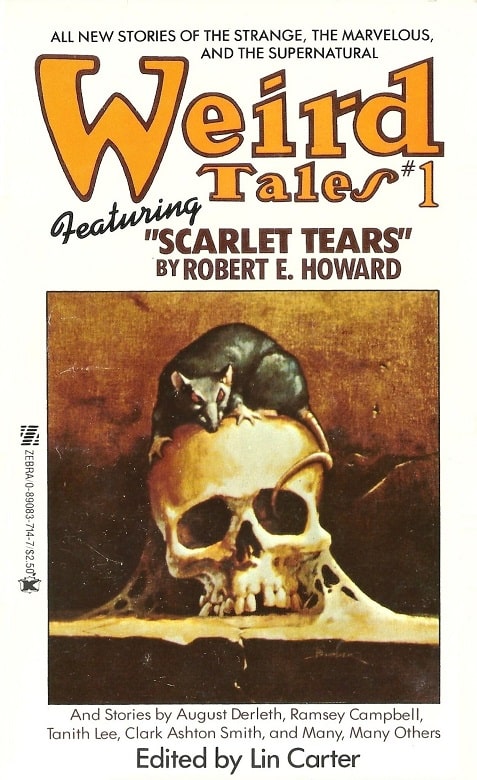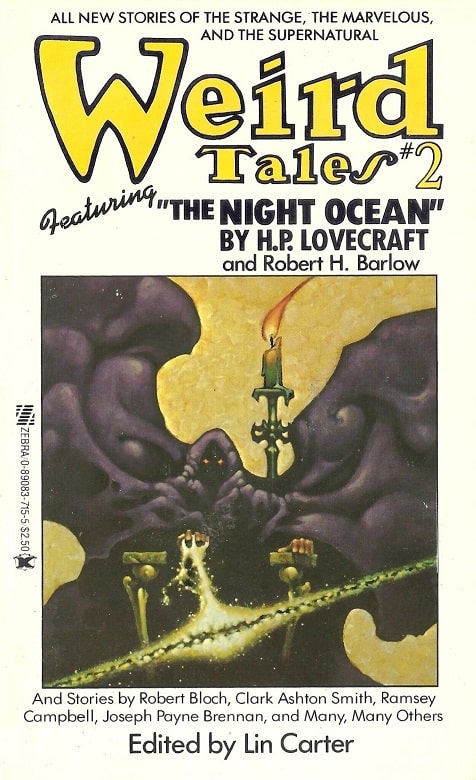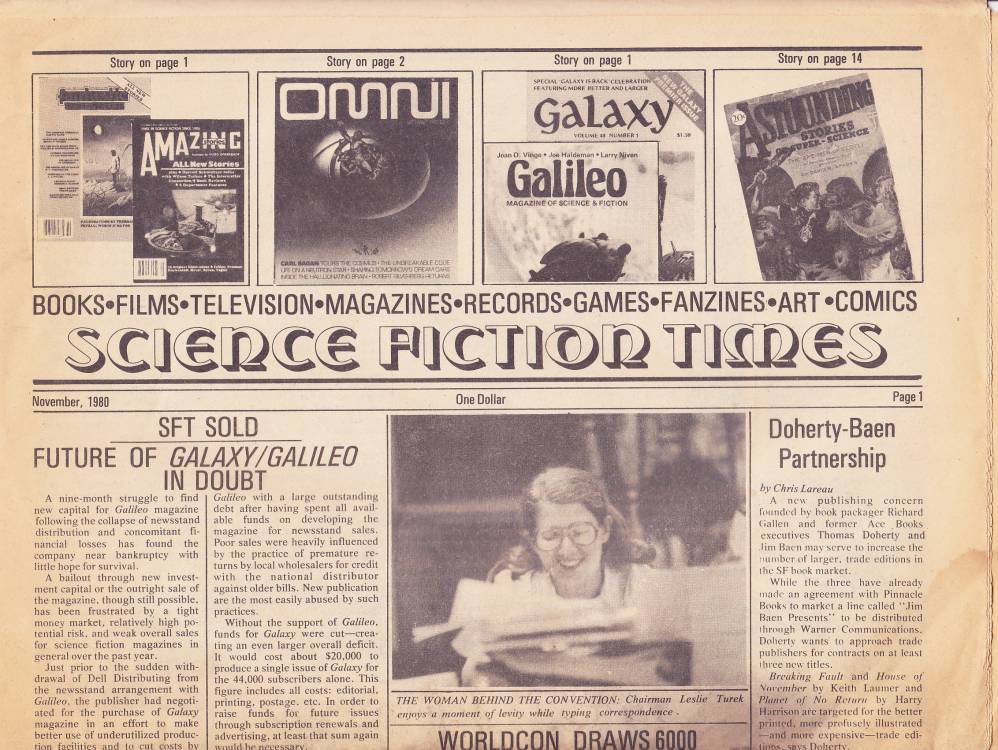Vintage Treasures: Lin Carter’s Weird Tales, Part II
Table of Contents for Weird Tales 1, edited by Lin Carter (Zebra Books, December 1980)
For yesterday’s Vintage Treasures post, I finally had the chance to discuss Lin Carter’s early-80s attempt to resuscitate the Magazine that Never Dies, the long-running weird fiction pulp Weird Tales.
Since I examined all four paperbacks, there wasn’t room in that article to look back at some of the fascinating discussions they’ve triggered over the last four decades, including lengthy commentary from Carter himself — especially his (largely unfulfilled) plans for the future volumes — or reviews of the stories within from modern readers. So I took the time to do that today.
Science Fiction Times, November 1980
Zebra Books’ launch of Weird Tales as a paperback magazine in 1980, with the highly respected editor Lin Carter at the helm, didn’t produce the breakout sales the publisher was looking for, but it did generate a tremendous amount of curiosity.
Carter was interviewed extensively for the relaunch, and in a wide-ranging interview in Science Fiction Times he commented at length on his plans.
I am reviving Weird Tales with the cooperation of Zebra Books, and I’m so thrilled — it’s one of those things that I never dreamed could ever happen, when I was fourteen years old and picking up Weird Tales on the newsstand, in helpless admiration of the writers in it, and to find myself the fifth editor of Weird Tales in half a century is a dream come true that I never dared to dream. It’s like having an Arkham book published. I had an Arkham book published, I never dreamed I could have an Arkham House book published. I have only two dreams left, that’s to write an Oz book and to do my Tarzan [Laughs].
“With Weird Tales, well, I guess I’m best known for sword and sorcery, and I want to promise people that I’m not going to turn Weird Tales into half sword and sorcery and half Cthulhu mythos. It’s going to be exactly the same magazine it always was. The mainstay of the thirty years that Weird Tales published regularly was always the urban horror story; the modern scene, urban horror story. We forget, because Conan and some of the swashbuckling Howard stuff attracts our attention, but in every issue, the bulk of the issue was modern day, urban-scene horror stories, and it’s going to be exactly like that, if I have to go out there and rewrite the stories. Thank God, Ramsey Campbell is out there; nobody has ever done the urban horror story better than Ramsey, and Ramsey has a story in the first issue and a story in the second issue, and he’ll have a story in every issue if I have anything to say about it, which of course I do. There will be a little sword and sorcery, of course. There will be at least one story in every issue. There will be Cthulhu Mythos stories, when I get good Cthulhu Mythos stories, but the rest of the stuff is going to be as close to the stuff Weird Tales used to print as possible. The fact that it’s coming out as a paperback periodical — I think the reason that the pulp magazines went under in 1954 was that pulp magazines no longer had space on the newsstands, because of the rise of the paperback book. You could either buy a magazine for 25 cents or a book. And people wanted the books. So, since we can’t lick ’em, we gotta join ’em…
Science Fiction Times, March 1980
Ramsey Campbell appeared in the first two volumes of Weird Tales. In a 2017 comment on Douglas A. Anderson’s Tolkien and Fantasy blog he said:
For the record, I also appeared in the first issue with “Down There.” “Trick or Treat” wasn’t my title (“The Trick” was), and I didn’t know it had been changed until the issue came out. Lin did also buy “Calling Card,” but it didn’t appear, and he rejected “The Voice of the Beach” as being insufficiently Lovecraftian.
In his introduction to the fourth volume, Lin Carter does in fact say, “a new story, “Calling Card,” appears in this issue. It is the work of the superb young British writer, Ramsey Campbell.”
However, the story is nowhere to be found! It eventually appeared in 65 Great Spine Chillers in 1982.
 |
 |
Weird Tales , Volumes 1 and 2 (Zebra Books, December 1980). Covers by Tom Barber
Of primary interest to Black Gate readers are Carter’s comments on the material planned for Weird Tales originally intended for Carter’s Ballantine Adult Fantasy Line, which came to an end in 1974. From the same Science Fiction Times interview:
I’ve been sitting on a pile of stuff ever since the Ballantine series dropped out from under me. I’ve had people from all over the world sending me Xeroxes and manuscripts of things that they happened to have. I’ll mention a 10,000 word fraction of a novel by Clark Ashton Smith that was sent to me from New Zealand, which is not known to otherwise any longer exist.
The Ballantine series did not last long enough for me to get all of these things into print. For example, there’s a trove of short stories by Hannes Bok, who of course is much better remembered as an artist and an illustrator, but did about seven stories for Weird Tales over the years. Not the best stories in Weird Tales, but still…
Ever since the idea of Weird Tales has come up, I have been calling, writing, begging, asking — and there are enough of the old authors, there are enough of the surviving members of the Weird Tales group still writing, that I can, at least with the first four issues, bridge the gap between what Weird Tales was and what Weird Tales will have to be in the future, because we are running out of the original authors. Obviously, to be viable to go on for years it will have to depend on the newer authors like Gary Myers, Tanith Lee, Ramsey Campbell, Brian Lumley. But Joseph Payne Brennan has given me a story. Carl Jacobi has given me two stories. I have a story from Robert Aickman; also one of the newcomers. I have unearthed unpublished stories by Howard, by Smith, by David H. Keller. I have this trove of Hannes Bok stories. I have stories promised me from Frank Belknap Long and Mary Elizabeth Counselman. I just received a story from Manly Wade Wellman. And I’m gonna do my damnedest to coax and wheedle stories from C.L. Moore, E. Hoffmann Price. Robert Bloch, Ted Sturgeon, people like that.
You see, Weird Tales lasted such an incredible length of time — a human lifetime, thirty years of publishing, that towards its end, a lot of the authors were fairly young. And there’s still a residuum of unpublished work by the great masters — a little bit is left. Howard and so forth.
I was completely unaware that such as thing as a ‘novel fragment’ by Clark Ashton Smith has survived. It never appeared in Carter’s Weird Tales, but was eventually published, as “The Infernal Star,” in Strange Shadows: The Uncollected Fiction and Essays of Clark Ashton Smith , edited by Steve Behrends, with Donald Sidney-Fryer and Rah Hoffmann.
Strange Shadows: The Uncollected Fiction and Essays of
Clark Ashton Smith (Greenwood Press/Bloomsbury Academic, 1989)
What happened to the Zebra Weird Tales, and why did only four issues appear?
As I mentioned in Part 1, the paperback relaunch was as criminally underfunded as the original pulp magazine, and Zebra (a notoriously budget-conscious publishing house) stopped paying the license to the owners almost immediately. The license was revoked in 1982, although that didn’t stop Zebra from publishing the final volume they’d already paid Carter for.
Douglas A. Anderson had a concise summary at his Tolkien and Fantasy blog in 2017.
The license of Weird Tales to Lin Carter and Zebra was revoked in 1982 owing to non-payment (though Zebra went ahead and published issue number 4 in 1983). Zebra seems always to have worked on the edge of financial disaster, and they were known to pay only very small advances and to be lax about accounting for sales and subsequent royalties. It is probably this financial instability that doomed from the outset both Lin Carter’s new fantasy series, as well as the revival of Weird Tales. It was a sad last hurrah for Lin Carter’s editing career.
Lin Carter found an black spot on his cheek and was diagnosed with oral cancer in 1985, and died three years later, at the too-young age of fifty-seven. His death was a major loss.
G.W. Thomas at Dark Worlds Quarterly has a fascinating breakdown on the fiction in all four volumes.
[Carter] congratulates Leo Marguiles and Sam Moskowitz (the last two crazy enough to try it) for their four issues in 1973-4, known as the California issues. He figures in his first editorial to avoid their fate by making WT a paperback magazine. And then he proceeds to do exactly what they did….
When you look at the contents of a Weird Tales resurrection you will inevitably find the following categories: (1) lost stories by old WT alumni such as Lovecraft, Robert E. Howard or Clark Ashton Smith. (2) These may be wholly theirs but there is a good chance they have been “finished’ by younger hands—posthumous collaborations. (3) Then there are the new pastiches of the Cthulhu Mythos or similar fare. (4) There is the classic “Weird Tales Reprint” (ie. stuff you already read from 1936), plus (5) new stories by the old authors who still survive, and finally, (6) a small number of new writers that supposedly follow the WT tradition. These names bring current readers to the magazine. These are your best hope of finding something new worthy of reading.
Let’s break down the four issues using these criteria:
Newly discovered stories from ex mortis WT alumni
Robert E. Howard
Issue 1:
- “Scarlet Tears” by Robert E. Howard”
- “Someone Named Guiberg” by Hannes Bok
- “The House Without Mirrors” by David H. Keller
- “Red Thunder” by Robert E. Howard
Issue 2
- “Song of the Gallow’s Tree” by Robert E. Howard
Issue 3
- “To the Nightingale” by Clark Ashton Smith
Issue 4
- “The Doom-Chant of Than-Kul” by Robert E. Howard
- “The Sea-Gods” by Clark Ashton Smith
Posthumous collabs
Clark Ashton Smith
- Issue 1: “The Light from the Pole” by Clark Ashton Smith and Lin Carter
- Issue 2: “Descent Into the Abyss’ by Clark Ashton Smith and Lin Carter
- Issue 3: “The Guardian of the Idol” by Robert E. Howard and Gerald W. Page…
In the final analysis, I have to give Carter credit for his selections, though perhaps a little too much Cthulhu Mythos pastiches for my taste (I think I loved them when I bought this back in 1981, now, not so much.) He represents horror well, though he hasn’t any Science Fiction or much Sword & Sorcery (which is probably smart from a marketing POV). He includes poetry (which Marvin Kaye entirely ignores in Weird Tales: The Magazine That Never Died, 1988). What’s missing in Carter’s magazine are the illustrations and the letters. This is supposed to be a magazine, not just a paperback anthology. The Eyrie was such a part of what Weird Tales was, I am surprised he dropped the letters after issue one.
So what do modern readers make of the paperback Weird Tales?
 |
 |
Weird Tales , Volumes 3 and 4 (Zebra Books, 1981 and
August 1983). Covers by Tom Barber and Doug Beekman
There are over a dozen reviews at Goodreads, with the usual mix of commentary. Craig gave Volume 1 4-stars, saying,
Carter did an exemplary job of assembling pieces from most of the most famous authors closely associated with the classic years of Weird Tales, including a story and a poem from Robert E. Howard, a story by Clark Ashton Smith, and he reprinted an obscure Seabury Quinn story that had appeared in a rival magazine in 1941. The only notable omission is H.P. Lovecraft, I believe. There’s also a story by August Derleth reprinted from Weird Tales‘ May, 1926 issue, but all of the other selections appeared here for the first time… Some of the works are quite dated, of course, but they’re all fun and spirited tales. It was a very impressive debut effort from Carter, who also contributed interesting commentary throughout.
Derek at Goodreads gave Volume 2 only 2-stars, saying in part,
The selections do carefully emulate what would be found in the pages of the original Weird Tales magazine, even excavating a lonely tag-end Lovecraft story to use as the headlining item, and featuring a Nictzin Dyalhis story that was originally in a 1934 issue.
I didn’t care for the Lovecraft piece, which to be clear was something Lovecraft (entirely?) rewrote from Barlow’s request for an edit. It builds a long, slow mood of alienation and horror, against both the alien dark ocean and against trite popular culture of the nearby tourist town. While its sense-impressions are extremely specific and it builds to a pitch, it doesn’t hide the fact that nothing much happens and that the only character aside from the faceless/usual narrator is the ocean itself.
The standout new material was “Boy Blue” and “The Sombrus Tower,” both of which use the enigma of the events or setting to cast a particularly unsettling mood…. “The Sombrus Tower” has the stately weirdness of existential Swedish cinema. A knight approaches his doom, the explanation of which is circled around but never handed to the reader. A strange, lovely dream quest.
Campbell’s craftsmanship in “Trick or Treat” is evident in the conjured imagery… Like “Boy Blue” the horror is enhanced by the perspective. In this case, seeing horrible events from the distorted and non-comprehending view of the very young.
Carter does a posthumous collaboration — “The Descent Into the Abyss” — with Clark Ashton Smith, whose style Carter should not be allowed within five miles, and which is another Mythos piece. Again, it is lathered too thick, with five references where one effective one would suffice. It is in the mode of Smith’s “The Seven Geases,” a series of weird encounters drawing the protagonist closer to the mind-blowing center, and it very nearly achieves its mark with the primordial idiot deity Ubbo-Sathla, but then slams the door on the blasting horror revealed to the sorcerer but not even hinted to the reader.
Derek was more appreciative of Volume 3, saying:
Lin Carter might be a diligent and discerning editor and curator of anthologies, but he is also backwards-looking, as seen in his Ballantine Adult Fantasy work and in the intensely imitative styling of his own writing. (I look forward to checking this assertion against Flashing Swords! and The Year’s Best Fantasy Stories)… It contains recycled material from as far back as 1925, famous and established names, and tried-and-true formats and formulas. What was “weird” in the 1930’s was conventional in 1981…
This is the first I’ve read of Manly Wade Wellman’s Silver John, and it will not be the last. Likewise, I’m intrigued by Donald Wandrei’s “The Red Brain.”
But the story that most sticks out as a ‘weird tale’ is Steve Rasnic Tem’s “The Messenger.” It was cryptic, unsettling, and the most daring thing in the volume.
Our coverage of the Lin Carter Weird Tales includes:
Weird Tales #1, edited by Lin Carter (2014)
Lin Carter’s Weird Tales, Part 1 (2023)
Lin Carter’s Weird Tales, Part 2 (2023)
See all our recent Vintage Treasures here.



I’ve always imagined Lin Carter as a Genius level Editor. Many books by him I did buy for his editorials or being on the subgect as much as hunting down stories by this or that author then I realized I was a Lin Carter collector and fan. He was a great writer but he rescued so many Genius and transcedental level ones from obscruity that his own seemed “Hack” level in comparison. It might not have helped that he did his own stories in their genres though some might note he did novels in EVERY Genre he published.
Suggestion:
The concept of stories IN a genre as an article here? Scifi and even modern Fantasy are relatively new genres, only trailed a bit by Mystery/Detective. Horror and Romance as we see them were well established with the Romantic movement from the late Renissance, the beginning of Gothic Literature as its called now. Westerns got established by the Penny Dreadfuls dreaming of the last real frontier on this world though they had plenty of African Explorers and such, the roots of Indiana Jones.
New works in the genre – Sword and Planet, Sword and Sorcery, Space Opera… of the sci-fi/fantasy get burndened by the legacy. “How many Space Invaders want our women…” – there was a joke in an old OMNI about that – neat tree of branches for science fiction cliche stories. Funny – but tell me how many “Gentleman Pirate” covers has Fabio appeared on? “Piracy in a Scurvy Age” How many endless “Westerns” out there. What about those shelf-groaning trees worth of “Romance” novels? So the article might be out writing new stuff in an established genre – as Lin Carter did.